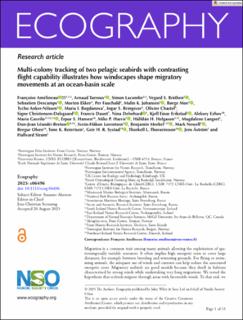Multi-colony tracking of two pelagic seabirds with contrasting flight capability illustrates how windscapes shape migratory movements at an ocean-basin scale
Amelineau, Francoise; Tarroux, Arnaud; Lacombe, Simon; Bråthen, Vegard Sandøy; Descamps, Sebastien; Ekker, Morten; Fauchald, Per; Johansen, Malin; Moe, Børge; Anker-Nilssen, Tycho; Bogdanova, Maria I.; Bringsvor, Ingar S.; Chastel, Olivier; Christensen-Dalsgaard, Signe; Daunt, Francis; Dehnhard, Nina; Erikstad, Kjell E.; Ezhov, Aleksey; Gavrilo, Maria; Hansen, Erpur S.; Harris, Mike P.; Helgason, Halfdan Helgi; Langset, Magdalene; Léandri-Breton, Don-Jean; Lorentsen, Svein-Håkon; Merkel, Benjamin; Newell, Mark; Olsen, Bergur; Reiertsen, Tone Kristin; Systad, Geir Helge Rødli; Thorarinsson, Thorkell L.; Åström, Jens; Strøm, Hallvard
Peer reviewed, Journal article
Published version

Åpne
Permanent lenke
https://hdl.handle.net/11250/3115991Utgivelsesdato
2023Metadata
Vis full innførselSamlinger
- Publikasjoner fra CRIStin - NINA [2364]
- Scientific publications [1392]
Sammendrag
Migration is a common trait among many animals allowing the exploitation of spatiotemporally variable resources. It often implies high energetic costs to cover large distances, for example between breeding and wintering grounds. For flying or swimming animals, the adequate use of winds and currents can help reduce the associated energetic costs. Migratory seabirds are good models because they dwell in habitats characterized by strong winds while undertaking very long migrations. We tested the hypothesis that seabirds migrate through areas with favourable winds. To that end, we used the SEATRACK dataset, a multi-colony geolocator tracking dataset, for two North Atlantic seabirds with contrasting flight capabilities, the black-legged kittiwake Rissa tridactyla and the Atlantic puffin Fratercula arctica, and wind data from the ERA5 climate reanalysis model. Both species had on average positive wind support during migration. Their main migratory routes were similar and followed seasonally prevailing winds. The general migratory movement had a loop-shape at the scale of the North Atlantic, with an autumn route (southward) along the east coast of Greenland, and a spring route (northward) closer to the British Isles. While migrating, both species had higher wind support in spring than in autumn. Kittiwakes migrated farther and benefited from higher wind support than puffins on average. The variation in wind conditions encountered while migrating was linked to the geographical location of the colonies. Generally, northernmost colonies had a better wind support in autumn while the southernmost colonies had a better wind support in spring, with some exceptions. Our study helps understanding how the physical environment shapes animal migration, which is crucial to further predict how migrants will be impacted by ongoing environmental changes. Multi-colony tracking of two pelagic seabirds with contrasting flight capability illustrates how windscapes shape migratory movements at an ocean-basin scale
